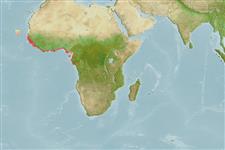Classification / Names
Common names from other countries
Main reference
Size / Weight / Age
Max length : 50.0 cm TL male/unsexed; (Ref. 2295); common length : 30.0 cm TL male/unsexed; (Ref. 2295)
Length at first maturity
Lm 22.8, range 21 - ? cm
Environment
Marine; reef-associated; non-migratory; depth range 1 - 50 m (Ref. 2683)
Climate / Range
Tropical, preferred 27°C (Ref. 107945); 20°N - 5°S
Distribution
Eastern Central Atlantic: Senegal to Gabon; also Cape Verde, São Tome-Principe Islands, and Rolas Islands. There is little doubt that only a single species of Lethrinus exists in the tropical western Atlantic.
Countries | FAO areas | Ecosystems | Occurrences | Introductions
Short description
Dorsal
spines
(total): 10;
Dorsal
soft rays
(total): 9;
Anal
spines: 3;
Anal
soft rays: 8. The outer surface of the maxilla is smooth, without a knob or pronounced longitudinal ridge. Inner surface of the pectoral fin axil without scales. Overall color is olive green or brown and pinkish. The cheeks have a network of fine reticulations below the eye.
IUCN Red List Status (Ref. 115185)
Threat to humans
Harmless
Human uses
Fisheries: commercial
More information
ReferencesAquacultureAquaculture profileStrainsGeneticsAllele frequenciesHeritabilityDiseasesProcessingMass conversion
Tools
Special reports
Download XML
Internet sources
Estimates of some properties based on models
Phylogenetic diversity index
PD50 = 0.5000 many relatives (e.g. carps) 0.5 - 2.0 few relatives (e.g. lungfishes)
Trophic Level
3.5 ±0.46 se; Based on food items.
Resilience
Medium, minimum population doubling time 1.4 - 4.4 years (Assuming tm=2)
Vulnerability
Moderate vulnerability (37 of 100)
Price category
